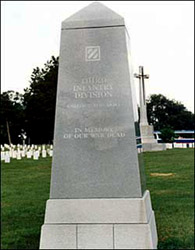|
Hours:
7 days a week, 365 days
8am-7pm (April-September)
8am-5pm (October-March)
Parking garage closes 1 hour after cemetery
Phone: (877) 907-8585
|
3rd Infantry Division Monument
Third Infantry Division Monument

The 3rd Infantry Division monument was approved by President George Bush on 29 September 1988 in Public Law 100-456. The memorial is located on the right (north) side of the curved part of Memorial Drive near the Canadian Cross and the Challenger memorial. The nine-ton gray obelisk is several feet behind its roadside marker. The bronze and stone marker lists battles fought by the 3rd Infantry. Two typographical errors on the markers: World War 1, and 11 instead of I and II. Famed World War II Medal of Honor recipient Major Audie Murphy of the 3rd Infantry is buried along the flagstone walkway in section 46 of the left (south) side the curved part of Memorial Drive. 3rd Infantry veterans including General Lloyd Ramsay, U.S. Army (retired) place a wreath there each Memorial Day and Veterans Day after their Army Wreath Ceremony at the Tomb of the Unknowns. Murphy's friend Carl Swickerath periodically visits to make sure the area around the monument, Murphy's grave, and Mrs. Swickerath's grave are kept neat. It is unknown who keeps the small U.S. flag placed at Murphy's government headstone.
U.S. Army "Rock of the Marne"
The 3rd Division was organized at Camp Greene, North Carolina, on 23 November 1917. All units of the Division were in France by March 1918. The Division entered combat in May. On July 15 it distinguished itself in defense of the Marne River at Chateau-Thierry, forty-five miles northeast of Paris. This action earned the Division the proud motto, "Rock of the Marne".
The 3rd Infantry Division fought with distinction in World War II, participating in four amphibious landings in North Africa, Sicily, Italy, and France. The Division played a crucial role in the defense of South Korea. It returned to Germany in 1957 as part of the NATO Defense Force and was there when the 3rd Division Memorial was dedicated on August 15, 1990.
| |
CAMPAIGNS |
KILLED |
WOUNDED |
MISSING |
| WW-I (1917-1918) |
6 |
3,401 |
12,764 |
691 |
| WW-II (1941-1945) |
10 |
5,558 |
18,766 |
554 |
| KOREA (1950-1953) |
8 |
2,160 |
7,939 |
292 |
|
|
|